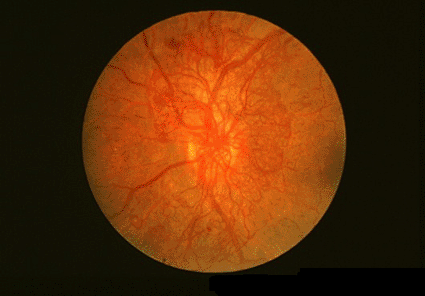Nanoparticle Gene Therapy Prevents Retinopathy in Rodent Model
By LabMedica International staff writers
Posted on 15 Jul 2009
Researchers working with a rat model have demonstrated a method for injecting gene-carrying nanoparticles directly into the animals' retinas to prevent or reverse the damage caused by diabetic retinopathy.Posted on 15 Jul 2009
During the progress of diabetes, the blood vessels that feed the retina may become damaged in different ways. The damaged vessels can have aneurysms that can leak blood into the surrounding vitreous material that fills the inside of the eyeball. They can become completely closed, or new vessels can begin to grow where there would not normally be blood vessels. Although these new blood vessels are growing in the eye, they do not nourish the retina, and they bleed easily, releasing blood into the inner region of the eyeball, which can cause dark spots and cloudy vision.

Image: Ophthalmoscope view of the retina of the eye in a diabetic patient showing retinopathy (Photo courtesy of Paul Parker / SPL).
Diabetic retinopathy is the leading cause of blindness in people ages 20 to 74. The syndrome will likely occur in 90% of persons with type I diabetes (insulin-dependent, or insulin requiring) and 65% of persons with type II diabetes (non-insulin-dependent, or not requiring insulin) by about 10 years after the onset of the disease.
To prevent or reverse retinopathy investigators at the University of Oklahoma Health Sciences Center (Oklahoma City, USA) incorporated the gene that encodes the angiogenesis inhibitor plasminogen kringle 5 (K5) into nanoparticles made from poly lactide-co-glycolide. Kringle 5 of human plasminogen has been shown to inhibit angiogenesis by inducing the apoptosis of proliferating endothelial cells. The investigators injected these nanoparticles directly into the retinas of rats with oxygen-induced retinopathy (OIR), a model for human diabetic retinopathy.
Results published in the June 2, 2009 online edition of the journal Diabetes, revealed high-level expression of K5 in the inner retina of the rats for the entire four weeks analyzed. The condition of the eye injected with the K5 gene was compared to the animal's other eye, which received an injection of nanoparticles lacking the gene. Results showed that a single injection of the nanoparticles stopped leakage from aneurysms, blocked inflammation, and kept unwanted blood vessels from growing. There was no detectable damage caused by the treatment to retinal structure or function.
"There is no good treatment for retinopathy, which is why we are so excited about this work. This opens an entirely new area for pharmaceutical companies to target," said senior author Dr. Jian-xing Ma, professor of molecular medicine at the Oklahoma University Health Sciences Center.
Related Links:
University of Oklahoma Health Sciences Center













